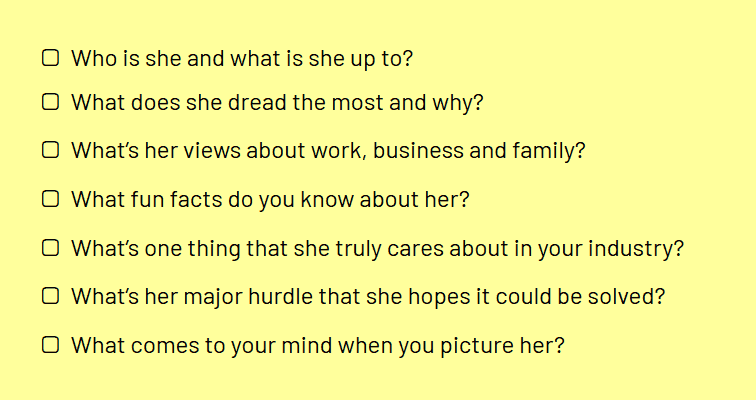Your home-based digital business solely relies on your Ideal customer. This is the person you want to fall in love with as soon as possible (Hint: this person is not you.) Your ideal customer is the person looking to explore the content and the products you’re developing.
Not all home-based businesses will require you to profile your customer, but if you want to ensure that your marketing efforts are effective, you need to.
What’s a Buyer Persona?
A buyer persona refers to a detailed description of your hypothetical ideal customer. This customer is a representative of your target audience, that is, someone you want to attract and sell to.
A buyer persona defines the customer’s identity in terms of personal details, demographics, interests, and behavioral traits. It also includes goals, challenges, pain points and purchase decisions and patterns.
You want to think of buyer personas as models, treating them as if they were real people, with feelings, preferences and emotions.
For many businesses, one buyer persona isn’t realistic since different groups purchase products for different reasons, and under different circumstances. To create more representative models, it’s necessary to develop different buyer personas.
What’s an Ideal Customer Profile?
An ideal Customer Profile is a hypothetical description of the organization that would benefit the most from using your products and services. It highlights our ideal customer in terms of metrics such as demographics and psychographics.
Other terms used to refer to Ideal Customer Profile include:
- Buyer persona
- Customer avatar
- Consumer persona
- User persona
- Audience avatar
- Audience persona, amongst others.
Understanding your Ideal Customer
To develop the right audience avatar, you need to ask the right questions:

Where to get information for your Audience Avatar
If you are starting off without any sort of medium already set up, that is, Facebook page, or a website with Google analytics, then you can create your audience avatar by simply brainstorming what makes your ideal reader.
For those of you who have been marketing your business online for a while, you have several sources where you can pool data to inform your profiling process.
Facebook and Instagram Insights
Facebook is a great source of insights that can help you to better understand your target market. You can see industries that most of your audience fall into, their interests, age groups and gender ratio.
Better still, you can analyze competitors to see what their demographics look like:
Facebook audience insights tool: If you have a Facebook page, you can set up a free ad account and use audience insights tool to describe what makes your ideal audience.
You can also get similar insights when you view your Instagram Insights if you have switched to a business account. The native insights tool for business accounts can tell you when your audience are active on the platform, your most popular posts and your account’s reach and total impressions. You can also view the impressions of each of your posts. If you want more detailed reports, you can use a dedicated premium Instagram Insights tools such as Iconosquare, Socialbakers, Pixlee and Squarelovin
Website Analytics
After running your website or your blog for a few months, you should be able to access several insights through Google Analytics and Google Search Console (GSC).
As long as your website has had Google analytics active for a while, you should be able to access this information by going to Audience, then Demographics from your Analytics dashboard. This therefore means you need to set up Google Analytics and Search console as early as possible, preferably from the word go so that you can start collecting this data.
Pinterest Analytics
If you have been using Pinterest to promote your blog posts and products, then it’s worth checking their audience analytics tool to have an idea about your audience: gender, age, and topical interests.
Pinterest is a great platform for industries such as beauty and fashion, DIY, food and beverages,
Though I didn’t use this info in isolation, given that Pinterest audience doesn’t really reflect my blog audience in entirety, it did help me rethink about some of the categories that I wasn’t paying attention to at all. E.g., Making money online.
How to Create a Buyer Persona in Minutes with Persona Explorer
While the process above can be done for free, it requires months of data collection and plenty of time analyzing data. Not to mention, when starting off you don’t have this data to begin with. This therefore means, for a few months of running your business, all of your content creation and marketing efforts will be based purely on instincts and market assumptions.
This isn’t good for business and can be costly in the long run. When you commit time to marketing, you want to know that your efforts will stick. This is hard to tell when you don’t fully understand who you are talking with.
The good news is, with a tool like Persona Explorer, you can leverage their extensive datasets and create a highly relevant and data-backed customer persona within minutes. All you have to do is to select a Persona that best describes your customer in the Persona Library and moving on to customize her details over a few guided steps.
At the end of the process, you have a customer persona based on real human science and personality science that you can then rely on to guide your content creation direction and overall brand messaging.
You can also use this tool to have a detailed personality report that shows the demographics of your ideal customer with vital information such as how they are likely to respond to your brand or product.
Try Persona Explorer free for 12 hours
What to Include in Your Buyer Persona Profile.
The perfect buyer persona should have:
- Insightful data from sources such as website analytics, social media insights, market research, customer research.
- A visual that humanises their profile, in a meaningful way.
- Accurate analysis of their general location, lifestyle, and income
- A representation of their communities, view of life and perspectives around your industry.
- The beliefs and values of the target audience.
- Their take on issues in your industry, for example if you are an AI powered copywriting tool, find out how do they generally feel about the innovation.
- Reasoning behind likely brand or product decisions.
- An overview of the personality traits shared by the key audience.
- Actionable interpretation of how these traits align with the brand goals.
- A format that is sharable and comprehendible by all in the company.
How to Use Buyer Personas
ICPs are important since they help:
Sales teams to determine what leads to target. By targeting leads who are highly likely to use your product, you tremendously reduce the sales cycle.
Help marketers to craft the right content and messaging that speaks the language of their ideal customer. By creating content that resonates with your prospects, you increase the chances of conversion.
Examples of Powerful Messaging Powered by ICPs
By understanding the person that your product or service is designed for, you save yourself the pain of vanity metrics that have no effect on the bottom line. You do not need a list of 20,000 generic users. What you need is a list of 2000 or 500 loyal subscribers who adore you and your products.
To give you a rough idea, let’s look at these two examples spanning across several monetization models:
| Monetization Model | Nicheing | Profiling Information |
| Freelance Services | SaaS Freelance Writer | The customer is a software developer or an owner of a SaaS company who is looking for content that attract organic traffic, bring targeted audience and compel them to take action My Promise: I’m a freelance writer that helps SaaS companies develop content that boosts leads and generate organic SEO traffic. |
| Printables | Home schooling / Meal plans / Work from home / Home décor Printables for Busy Moms | The customer is a busy mom juggling work, her side hustle and her family life. She’s looking for ways to stay organized and get stuff done quickly. My promise: I’m an organizational nerd helping moms with easy-to-use printables that help them with their homeschooling needs/ Meal plan needs/ Home décor needs (Pick just one) |
A 360 knowledge of your ideal audience will help you in successfully segmenting your list, so you can promote the right offers to the right customers.
Ideal Customer Avatar Example
To help you understand your audience, have a look at one of my own audience avatars here at PennyMatters.
| Demographics | Sources of Information | Goals and Values | Perceived Roadblocks |
| Name: Jessica the Solopreneur | Books: Becoming by Michelle, Zero to one | Jessica hopes to: | Jessica is challenged with: |
| Age: 32 | Magazines: Forbes, Entrepreneur, NYC Times | 1. Reach more people with her content and products | Low website traffic to her blog/business website |
| Country: US | Blogs: Copyblogger, Smart Passive Income | 2. help her customers with impactful content | Inability to create highly valuable content faster and consistently |
| Education: College graduate | Influencers: Mare Forleo, Ryan Rob, Melyssa Griffins | 3. Make more sales | Few sales of her digital products |
| | | 4. Create more quality digital products | Piling up blogging and business costs |
| | | 5. Add more email subscribers | Not enough quality subscribers to Jessica’s list |
If you operate a small business example, dealing with physical products, you can expect that the direction of your avatar will be totally different. You will be looking for local publications and local blogs and directories instead.
Make sure your ideal audience profile name is reflective of the industry you are in. e.g., If you are in a Food recipe niche, then you may have someone like “Daisy, the home-made food enthusiast.” as the name of your ideal reader.
I love adding the second name as the audience description rather than the actual last name. This will help me to always focus on what she is up to every day.
Plus, if I have different audience avatars, it becomes differentiating feature.
For instance, I could add another avatar on PennyMatters, say “Brian the freelancer”
So, whenever I’m creating content for this audience profile, I’ll always be picturing a freelancer, rather than a course creator for instance solopreneur, being the end user of the content.
This way, I’ll craft more compelling content that speaks their language.
Conclusion
I hope this little guide on how to create a buyer persona has helped you to better understand the need to profile your audience in order to make your marketing efforts more effective and


